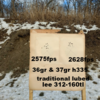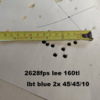archeryrob
Member
Does powder coat make up for hardness?
I cast a bunch of NOE 312 184 grain bullets for a gas checked round cast with 11bhn wheel weight lead for the 30-30. All water quenched tested one and it came out 14 - 15 maybe. I did a bunch with deer fat lube to load plain and I powder coated some. I did not like pan lubing them as it was messy, but they looked really cool natural. Then I powder coated a bunch and sized them all to .309 and run on 3031
Shot the gun in at 50 yards with iron sites and lead and powder coat rounds was on. At 100 yards the powder coated rounds was still on and the lead rounds where 6" low and right. Is the 14bhn too soft and does powder coat make up for this? Or is something else going on?
I cast a bunch of NOE 312 184 grain bullets for a gas checked round cast with 11bhn wheel weight lead for the 30-30. All water quenched tested one and it came out 14 - 15 maybe. I did a bunch with deer fat lube to load plain and I powder coated some. I did not like pan lubing them as it was messy, but they looked really cool natural. Then I powder coated a bunch and sized them all to .309 and run on 3031
Shot the gun in at 50 yards with iron sites and lead and powder coat rounds was on. At 100 yards the powder coated rounds was still on and the lead rounds where 6" low and right. Is the 14bhn too soft and does powder coat make up for this? Or is something else going on?











